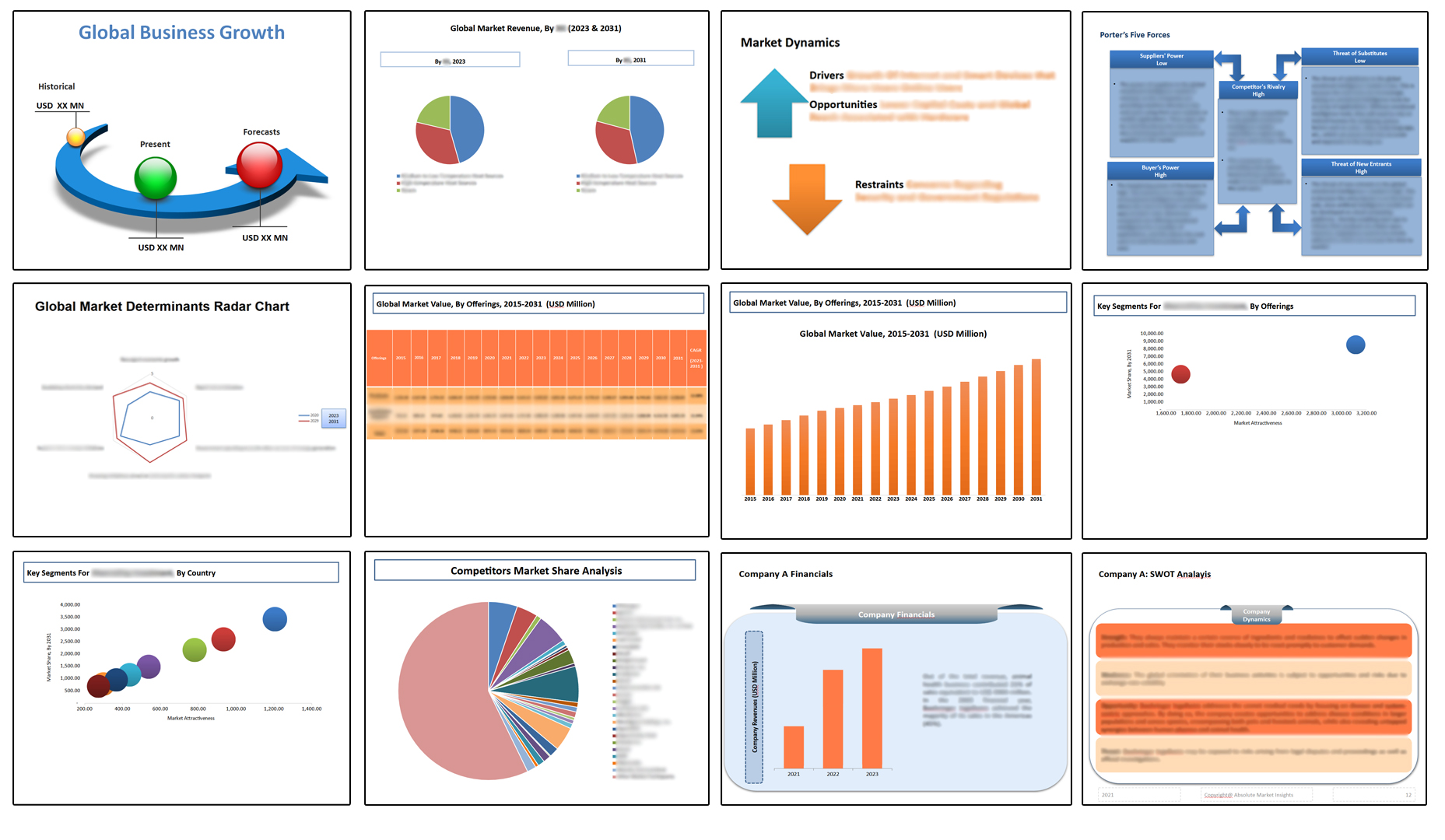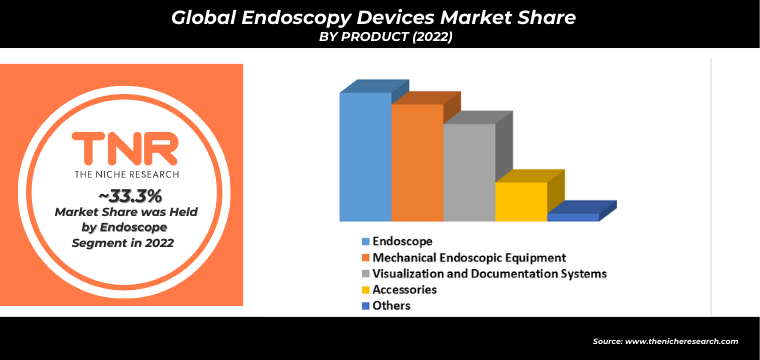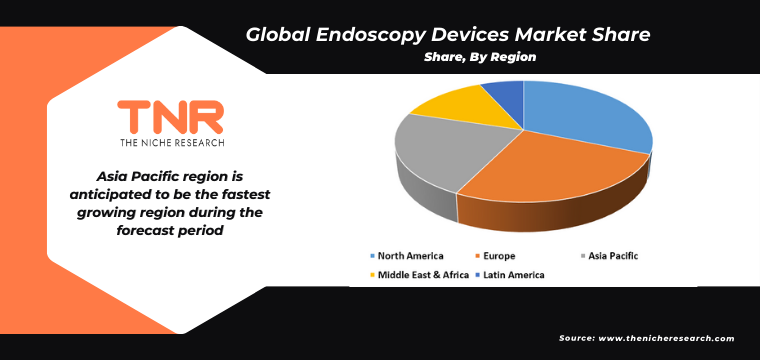Global Endoscopy Devices Market By Product, By Hygiene, By Application, By End User, By Region: Global Insights, Growth, Size, Comparative Analysis, Trends and Forecast, 2023 – 2031
- Industry: Healthcare
- Report ID: TNR-110-934
- Number of Pages: 420
- Table/Charts : Yes
- November, 2023
- Base Year : 2024
- No. of Companies : 10+
- No. of Countries : 29
- Views : 10238
- Covid Impact Covered: Yes
- War Impact Covered: Yes
- Formats : PDF, Excel, PPT
Global Endoscopy Devices Market was valued at US$ 28.9 Billion in 2022, Growing at an Estimated CAGR of 7.57% from 2023-2031.
Endoscopy devices are medical instruments used for non-invasive visualization and examination of internal body structures. They consist of a flexible or rigid tube with a light source and a camera attached, allowing doctors to see inside organs, cavities, and tissues. These devices play a crucial role in diagnosing and treating various medical conditions, such as gastrointestinal issues, respiratory disorders, and joint problems. Endoscopy procedures are generally minimally invasive, reducing the need for extensive surgeries and promoting quicker recovery times. The captured images and videos aid in accurate diagnosis, guiding medical interventions. These devices have revolutionized medical practices by enabling detailed internal observations, leading to improved patient care and outcomes.
In the global endoscopy devices market, the single-use hygiene segment is currently dominating, while the reprocessing hygiene segment is experiencing faster growth. The adoption of single-use endoscopy devices has surged due to concerns over infection control and patient safety. Hospitals and healthcare facilities are increasingly opting for single-use devices to minimize the risk of cross-contamination. For instance, a study published in the “Journal of Clinical Gastroenterology” found that 73% of endoscopy units in the US had shifted towards using single-use accessories to enhance infection prevention.
Global Endoscopy Devices Market Revenue & Forecast, (US$ Million), 2015 – 2031

COVID-19 Impact Analysis on Global Endoscopy Devices Market
Before the COVID-19 pandemic, the endoscopy devices market was experiencing steady growth driven by advancements in medical technology, rising prevalence of chronic diseases, and increasing demand for minimally invasive procedures. The market was characterized by a balance between established players and emerging innovations, with a focus on improving diagnostic accuracy and patient outcomes. However, with the onset of the pandemic, the market faced disruptions due to postponed elective procedures, supply chain challenges, and a shift in healthcare resources towards COVID-19 management. Despite initial setbacks, the market demonstrated resilience as healthcare systems adapted to the new normal. Post-COVID-19, the market regained momentum, driven by the prioritization of infection control, increased telemedicine adoption, and a renewed emphasis on efficient diagnostic tools.
Report Coverage and Deliverables

Rising healthcare expenditure is a major driver of the endoscopy devices market, enhancing diagnostic precision and patient outcomes. In the US, for instance, healthcare spending has consistently increased, reaching $4.4 trillion in 2022, according to The Peter G. Peterson Foundation. This upward trend is attributed to factors such as population aging and the prevalence of chronic diseases. A survey by found that 26% of Americans reported problems paying medical bills in 2020, highlighting the need for advanced medical procedures like endoscopy to diagnose and treat these conditions, thus contributing to the market’s growth.
A notable restraint in the endoscopy devices market is the stringent regulatory approval process for new devices. This can lead to delays in product launches and increased development costs. According to data from the Food and Drug Administration (FDA), the average time required for the approval of Class II medical devices, which includes many endoscopy devices, can range from 6 to 12 months. Additionally, changes in regulatory requirements, such as those implemented under the European Medical Devices Regulation (MDR), have raised the bar for device safety and efficacy evaluations. These factors contribute to prolonged market entry timelines, impacting innovation and market expansion.

In the global endoscopy devices market, the gastrointestinal endoscopy application segment is currently dominating, while the neuroendoscopy application segment is experiencing fastest growth. The dominance of the “Gastrointestinal Endoscopy” segment is supported by its wide range of applications in diagnosing and treating gastrointestinal disorders. According to data from the American Society for Gastrointestinal Endoscopy (ASGE), gastrointestinal endoscopy procedures, such as colonoscopy and upper gastrointestinal endoscopy, account for a significant portion of overall endoscopic procedures performed globally. These procedures are crucial for early detection and treatment of conditions like colorectal cancer.
North America dominated the global endoscopy devices market in 2022. According to a report by the Healthcare Information and Management Systems Society (HIMSS), North America has been at the forefront of adopting electronic health records and telemedicine solutions, which also extend to endoscopy practices. The region’s higher healthcare expenditure and favorable reimbursement policies further contribute to its leadership position.

Competitive Landscape
Some of the key players operating in the global endoscopy devices market are
- Boston Scientific Corporation
- CONMED Corporation
- FUJIFILM Holdings Corporation
- HOYA Corporation
- Intuitive Surgical
- Johnson & Johnson Services, Inc.
- KARL STORZ GmbH & Co. KG
- Medtronic
- Olympus Corporation
- Richard Wolf GmbH
- Smith+Nephew
- Stryker
- Other Industry Participants
Report Summary of Global Endoscopy Devices Market
| Report Specifications | Details |
| Market Revenue in 2022 | US$ 28.9 Billion |
| Market Size Forecast by 2031 | US$ 45.98 Billion |
| Growth Rate (CAGR) | 7.57 % |
| Historic Data | 2015 – 2021 |
| Base Year for Estimation | 2022 |
| Forecast Period | 2023 – 2031 |
| Report Inclusions | Market Size & Estimates, Market Dynamics, Competitive Scenario, Trends, Growth Factors, Market Determinants, Key Investment Segmentation, Product/Service/Solutions Benchmarking |
| Segments Covered | By Product, By Hygiene, By Application, By End User |
| Regions Covered | North America, Europe, Asia Pacific, Middle East & Africa, Latin America |
| Countries Covered | U.S., Canada, Mexico, Rest of North America, France, The UK, Spain, Germany, Italy, Nordic Countries (Denmark, Finland, Iceland, Sweden, Norway), Benelux Union (Belgium, The Netherlands, Luxembourg), Rest of Europe, China, Japan, India, New Zealand, Australia, South Korea, Southeast Asia (Indonesia, Thailand, Malaysia, Singapore, Rest of Southeast Asia), Rest of Asia Pacific, Saudi Arabia, UAE, Egypt, Kuwait, South Africa, Rest of Middle East & Africa, Brazil, Argentina, Rest of Latin America |
| Key Players | Boston Scientific Corporation, CONMED Corporation, FUJIFILM Holdings Corporation, HOYA Corporation, Intuitive Surgical, Johnson & Johnson Services, Inc., KARL STORZ GmbH & Co. KG, Medtronic, Olympus Corporation, Richard Wolf GmbH, Smith+Nephew, Stryker, Other Industry Participants |
| Customization Scope | Customization allows for the inclusion/modification of content pertaining to geographical regions, countries, and specific market segments. |
| Pricing & Procurement Options | Explore purchase options tailored to your specific research requirements |
| Contact Details | Consult With Our Expert
Japan (Toll-Free): – +81 663-386-8111 South Korea (Toll-Free): – +82-808- 703-126 Saudi Arabia (Toll-Free): – +966 800 850 1643 United States: +1 302-232-5106 United Kingdom: +447537105080 E-mail: askanexpert@thenicheresearch.com
|
Global Endoscopy Devices Market:
By Product
- Endoscope
-
- Rigid
- Flexible
- Mechanical Endoscopic Equipment
- Visualization and Documentation Systems
- Accessories
- Others
By Hygiene
- Single-Use
- Reprocessing
- Sterilization
By Application
- Bronchoscopy
- Arthroscopy
- Laparoscopy
- Urology Endoscopy
- Neuroendoscopy
- Gastrointestinal Endoscopy
- Gynecology Endoscopy
- ENT Endoscopy
- Others
By End User
- Hospitals
- Ambulatory Surgery Centers and Clinics
- Others
By Region
- North America (U.S., Canada, Mexico, Rest of North America)
- Europe (France, The UK, Spain, Germany, Italy, Nordic Countries (Denmark, Finland, Iceland, Sweden, Norway), Benelux Union (Belgium, The Netherlands, Luxembourg), Rest of Europe)
- Asia Pacific (China, Japan, India, New Zealand, Australia, South Korea, Southeast Asia (Indonesia, Thailand, Malaysia, Singapore, Rest of Southeast Asia), Rest of Asia Pacific)
- Middle East & Africa (Saudi Arabia, UAE, Egypt, Kuwait, South Africa, Rest of Middle East & Africa)
- Latin America (Brazil, Argentina, Rest of Latin America)
Table of Contents
**Exclusive for Multi-User and Enterprise User.
Global Endoscopy Devices Market Segmentation
By Product
By Hygiene
By Application
By End User
By Region
**Note: The report covers cross-segmentation analysis by region further into countries
The Niche Research approach encompasses both primary and secondary research methods to provide comprehensive insights. While primary research is the cornerstone of our studies, we also incorporate secondary research sources such as company annual reports, premium industry databases, press releases, industry journals, and white papers.
Within our primary research, we actively engage with various industry stakeholders, conducting paid interviews and surveys. Our meticulous analysis extends to every market participant in major countries, allowing us to thoroughly examine their portfolios, calculate market shares, and segment revenues.
Our data collection primarily focuses on individual countries within our research scope, enabling us to estimate regional market sizes. Typically, we employ a bottom-up approach, meticulously tracking trends in different countries. We analyze growth drivers, constraints, technological innovations, and opportunities for each country, ultimately arriving at regional figures.Our process begins by examining the growth prospects of each country. Building upon these insights, we project growth and trends for the entire region. Finally, we utilize our proprietary model to refine estimations and forecasts.
Our data validation standards are integral to ensuring the reliability and accuracy of our research findings. Here’s a breakdown of our data validation processes and the stakeholders we engage with during our primary research:
- Supply Side Analysis: We initiate a supply side analysis by directly contacting market participants, through telephonic interviews and questionnaires containing both open-ended and close-ended questions. We gather information on their portfolios, segment revenues, developments, and growth strategies.
- Demand Side Analysis: To gain insights into adoption trends and consumer preferences, we reach out to target customers and users (non-vendors). This information forms a vital part of the qualitative analysis section of our reports, covering market dynamics, adoption trends, consumer behavior, spending patterns, and other related aspects.
- Consultant Insights: We tap into the expertise of our partner consultants from around the world to obtain their unique viewpoints and perspectives. Their insights contribute to a well-rounded understanding of the markets under investigation.
- In-House Validation: To ensure data accuracy and reliability, we conduct cross-validation of data points and information through our in-house team of consultants and utilize advanced data modeling tools for thorough verification.
The forecasts we provide are based on a comprehensive assessment of various factors, including:
- Market Trends and Past Performance (Last Five Years): We accurately analyze market trends and performance data from preceding five years to identify historical patterns and understand the market’s evolution.
- Historical Performance and Growth of Market Participants: We assess the historical performance and growth trajectories of key market participants. This analysis provides insights into the competitive landscape and individual company strategies.
- Market Determinants Impact Analysis (Next Eight Years): We conduct a rigorous analysis of the factors that are projected to influence the market over the next eight years. This includes assessing both internal and external determinants that can shape market dynamics.
- Drivers and Challenges for the Forecast Period:Identify the factors expected to drive market growth during the forecast period, as well as the challenges that the industry may face. This analysis aids in deriving an accurate growth rate projection.
- New Acquisitions, Collaborations, or Partnerships: We keep a close watch on any new acquisitions, collaborations, or partnerships within the industry. These developments can have a significant impact on market dynamics and competitiveness.
- Macro and Micro Factors Analysis:A thorough examination of both macro-level factors (e.g., economic trends, regulatory changes) and micro-level factors (e.g., technological advancements, consumer preferences) that may influence the market during the forecast period.
- End-User Sentiment Analysis: To understand the market from the end-user perspective, we conduct sentiment analysis. This involves assessing the sentiment, preferences, and feedback of the end-users, which can provide valuable insights into market trends.
- Perspective of Primary Participants: Insights gathered directly from primary research participants play a crucial role in shaping our forecasts. Their perspectives and experiences provide valuable qualitative data.
- Year-on-Year Growth Trend: We utilize a year-on-year growth trend based on historical market growth and expected future trends. This helps in formulating our growth projections, aligning them with the market’s historical performance.
Research process adopted by TNR involves multiple stages, including data collection, validation, quality checks, and presentation. It’s crucial that the data and information we provide add value to your existing market understanding and expertise. We have also established partnerships with business consulting, research, and survey organizations across regions and globally to collaborate on regional analysis and data validation, ensuring the highest level of accuracy and reliability in our reports.









